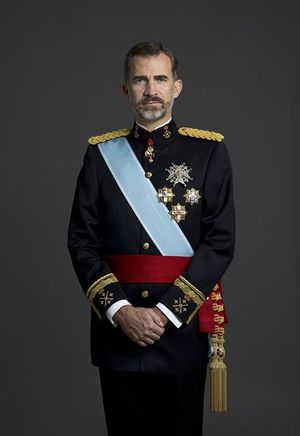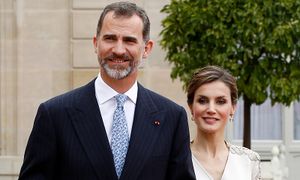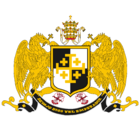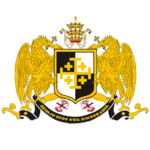Alexander II of Creeperopolis
| Alexander II | |
|---|---|
 | |
| Reign | June 18, 2003-present |
| Coronation | September 15, 2003 |
| Predecessor | Alfonso VI |
| 33rd Holy Protector of the State of the Church | |
| Reign | June 18, 2003-present |
| Predecessor | Alfonso VI |
| Supreme Pontiff | Juan Pablo II (2003-2005) Benedicto XVI (2005-2013) Francisco I (2013-present) |
| 11th Emperor of El Salvador | |
| Reign | June 18, 2003-present |
| Predecessor | Alfonso III |
| 11th Grand Prince of Creeperopolis | |
| Reign | April 29, 2002-June 18, 2003 |
| Predecessor | Alfonso IV |
| Successor | Alexander III |
| 33rd King of Senvar-Senvek | |
| Reign | June 18, 2003-present |
| Predecessor | Alphonse III |
| Reign | June 18, 2003-present |
| Predecessor | Alfonso II |
| Reign | June 18, 2003-present |
| Predecessor | Alfonso III |
| Born | September 15, 1983 San Salvador Imperial Palace, San Salvador, San Salvador, Creeperopolis |
| Spouse | Alexandra María Santos Tzul de Martínez (m. 2005) |
| Issue | |
| House | House of Martínez |
| Father | Alfonso VI |
| Mother | Angelina María Hernández Fuentes de Martínez |
| Religion | Creeperian Catholicism |
| Signature |  |
| ||
|---|---|---|
|
Emperor of Creeperopolis Reigning since 2003
Politics: Family: |
||
Alexander II of Creeperopolis (b. September 15, 1983, full name Alexander II Romero Adolfo Martínez Hernández) is the current reigning Emperor of Creeperopolis and the Creeperans. He rose to power and the imerpail throne of Creeperopolis on June 18, 2003, following the 2003 Creeperian Coup d'État which was staged by the by Creeperian Armed Forces and the National Intelligence Directorate.
The second child of Alfonso VI, Alexander II was raised by his father and uncles, Adolfo V and Romero III, but he was always in the shadow of Alfonso Martínez Hernández, his older brother, Grand Prince of Creeperopolis, and heir to the imperial throne of Creeperopolis. He entered the Creeperian military in 1991 and began learning Creeperian military tactics, preparing himself to fight the then long ongoing Third Senvarian Insurgency and the currently ongoing Mara War. He finished his studies in 1995 and entered the Creeperian Army immediately as a General.
Alexander became the Grand Prince of Creeperopolis upon the death of his older brother, Alfonso Martínez Hernández, on April 29, 2002. His father had ushered in a totalitarian Creeperian regime, known as the Alfonsisto upon his rise to power and instituted martial law on October 16, 1999. The Creeperian secret police, the National Intelligence Directorate (DINA), was ramped up in numbers and the armed forces felt ignored and began plotting a coup, especially after Alfonso VI signed a historic cease fire with Mara Salvatrucha during the Mara War in 2000. The Minister of Defense, Augusto Cabañeras Gutiérrez, approached Alexander and offered him the throne if he joined the coup plot against his father. After supposedly being bribed 30 million colóns, the Army, Navy, and the Air Force staged a coup on June 18, 2003, which killed Alfonso VI and allowed Alexander II to ascend to the imperial throne. Alexander II ended martial law and reinstated the Constitution. Supporters of Alfonso VI accused Alexander II and the armed forces of usurping the throne. As a consequence, thousands of supporters of Alfonso VI dissapeared froom 2003-2004.
Alexander II’s reign has been marked by rampant government and military corruption, high crime rates, and an increase of military activity in the Mara War and Deltinian Insurgency. Despite this, Alexander II is considered a very popular Emperor allowing patriotism and nationalism to be at the highest they have ever been since the conclusion of the Creeperian Civil War in 1949. He has also brought an end to the long ongoing Third Senvarian Insurgency and Castillianan Insurgency in 2020. Alexander II is accused of inciting and continuing ethnic violence in Creeperopolis.
Contents
Early Life
Alexander Romero Adolfo Martínez Hernández was born to Prince Alfonso Romero Martínez Escobar and Princess Angelina María Hernández Fuentes de Martínez on September 15, 1983, in the San Salvador Imperial Palace, San Salvador, San Salvador, Creeperopolis. He was the second son of Prince Alfonso Martínez Escobar. His older brother was Alfonso Romero Adolfo Martínez Hernández (1981-2002) and his younger brother was Salvador Romero Alfonso Martínez Hernández (1985-2003). He grew up and was raised in the San Salvador Imperial Palace throughout his childhood. He was always shadowed by his older brother Alfonso since he was his father's favorite and the heir to the Creeperian throne.
On April 29, 2002, Alfonso Martínez Hernández was shot in Adolfosburg when he was on his way to oversee the construction of a religious monument in the city. The bullet came from a sniper believed to be hiding in a nearby skyscraper. The country immediately went on high alert and the Army was stationed in the streets of Salvador, Adolfosburg, and San Salvador to thwart any other possible assassination attempts.
The National Intelligence Directorate was immediately ordered to investigate the assassination but the DINA found little to no evidence as to who the assassin was, where the assassin was, and why the Grand Prince was assassinated. Alfonso VI was infuriated at the poor investigation conducted by the DINA and he began to suspect that the DINA itself assassinated the Grand Prince. On October 19, 2002, Emmanuel Cabañeras Videla, the then Chief of the DINA, was assassinated in his home. It is heavily believed that Alfonso VI ordered the assassination. Cabañeras Videla was succeeded by his son, Augusto Cabañeras Gutiérrez, as Minister of Defense of Creeperopolis, Chief of the National Intelligence Directorate, and Chief Field Marshal of Creeperopolis.
The death of his older brother made Alexander Martínez Hernández the heir of Alfonso VI and the Grand Prince of Creeperopolis. Minister of Defense Augusto Cabañeras Gutiérrez, along with Chief Admiral José Guerrero López and Chief General Felipe Cambeiro Cavallería, began to formulate a plan to depose Alfonso VI and his totalitarian regime, commonly known as the "October 16 Regime" or the "Alfonsisto.
The three men conspiring the coup had no idea how the Creeperian people would react to the overthrow of their government. The three believed the regime to be unpopular, but there was no real way to find out at the time. They, however, knew how to gain the support of the people. The three approached Alexander Martínez Hernández, the eldest surviving son of Alfonso VI, and asked him if he wished to join in on the plot to depose his father. After a large bribe of 30 million colóns and promises of power, Alexander Martínez Hernández joined aboard the plot to overthrow Alfonso VI.[citation needed]
Reign
Coup and Accession
The coup to topple the totalitarian regime of Alfonso VI began on the command of Augusto Cabañeras Gutiérrez at 9:11am, San Salvador Time (SST), on June 18, 2003. The coup started with the I and II Creeperian Army Corps moving into positions to surround the city of San Salvador to prevent Alfonso VI escaping via land, followed by the III through XI Creeperian Army Corps setting up offensive positions in the city near the San Salvador Imperial Palace. The XII Creeperian Army Corps was stationed at the Alfonso I Martínez International Aiport. The División Negra, the elite of the Creeperian Army, was ordered to surround the Imperial Palace and to prepare for a storming of the Palace.
The V Creeperian Army Corps was ordered to begin the artillery shelling of the Imperial Palace at 9:58am. At 10:00am, the Army siezed a radio station in San Salvador and sent a broadcast to the nation saying:
"Do not fear faithful Creeperans. This is not a malicious nor foreign nor [Senvarian] takeover of the Fatherland or toppling of the government. Instead, the Armed Forces of the [Creeperian] Fatherland and the [Creeperian Catholic] Church have witnessed the totalitarianism of the regime of Alfonso VI. Under the guide of the Lord God, we are removing this wicked government from power and are installing a truthful, honest, and benevolent government, a new Emperor on the Imperial throne from the line of Martínez. Long live Creeperopolis! Long live the Fatherland! Long live God!"
The Army was then ordered to storm the Palace and to offer no quarter to the Imperial Guards who have "betrayed the Fatherland" (after the Air Force and artillery completed bombing the Palace). The guards were ruthlessly massacred by the Army, with an estimated 300 guards being slaughtered.
The day before the coup, Guerrero López quietly, without the knowledge of Alfonso VI, moved 50 warships to Lake San Salvador to prevent any possibility for the Emperor to flee via the lake.
The Air Force, under orders of Cambeiro Cavallería, captured the four major airports of San Salvador to prevent Alfonso VI from escaping via the air.
Then, the Air Force began bombing the Imperial Palace to damage any possible defenses and to kill as many guards as possible before it is stormed by the Army.
The day before the coup, Alexander Martínez Hernández left the Imperial Palace to Zapatista under the guise of inspecting Army positions in the area in preparation for an operation against Mara Salvatrucha in the Mara War. After leaving San Salvador, Martínez Hernández met up with Cabañeras Gutiérrez to prepare for the coup.
Throughout the coup, Martínez Hernández did little and was merely and observer in his rise to power.
The Imperial Guard was caught completely off guard by the coup. Of the total 70,000 Imperial Guards enlisted at the time, only 300 were at the Imperial Palace and ready to defend the Emperor.
Chief Guard Armando Figueroa Molina remained loyal to Alfonso VI and swore to defend the Emperor until the end. When the assault began with the bombings and shelling, several guards were killed and wounded. When the División Negra initiated the storming, all the guards were massacred, including Figueroa Molina. The remaining guards were forced to surrender and pledge allegiance to Alexander II following the coup.
Alfonso VI was taken completely by surprise by the coup. He knew that he had not kept the loyalty of the armed forces and that he will either be killed or imprisoned. When the shelling and bombing began, he moved to the bunker below the Imperial Palace. As the soldiers were storming the Palace, he committed suicide to prevent capture.
The Miracle of Creeperopolis
During the reign of Alfonso VI, the Creeperian economy declined from 2.4 trillion colóns in 1999 to 980 billion colóns by the time of the coup in 2003. The crippling conditions occured due in part due to a lack of economic support from Quebecshire and the totalitarian policies of nationalizing several private organizations in Creeperopolis from 1999 to 2003.
Following the coup, then Minister of the Treasury César Casaus Morillo was arrested and forcibly dissapeared and replaced by Adán Dávalos Santángel.[citation needed] Under Dávalos Santángel, many nationalized companies were privatized and heavy tax breaks were granted to the National Coffee and Sugar Corporation (CORNACA), the National Mining and Smelting Corporation (CORNAMIF), the United Creeperian Banana Company (EMUPLAC), and the Creeperian Petroleum Corporation (PETRÓCRE), large Creeperian monopolies which were and still are vital to the Creeperian economy. These tax breaks and other economic reforms were instituted by the Salvador Boys, economists who studied at the University of Salvador. The economic reforms implemented by the Salvador Boys had three main objectives: economic liberalization, privatization of state-owned companies, and stabilization of inflation.
From 2003 to 2019, the Creeperian economy skyrocketed from a gross domestic product of 980 billion colóns to 11.8 trillion colóns, making Creeperopolis the second largest GDP on Terraconserva. The rapid growth and success of the Creeperian economy has been coined the "Miracle of Creeperopolis" by Dávalos Santángel.
The Senvarian, Castillianan, and Mara Wars
Foreign Affairs
Domestic Popularity
International Popularity
Personal Life
Family

Issue
Politics
 |
|---|
| This article is part of a series on the politics and government of Creeperopolis |
|
Outline |
Creeperian Initiative
Military Service
Alleged War Crimes
Corruption
Corporate Corruption
Military Corruption
Religion
Views on Religion
Alexander II has been strictly raised as a Creeperian Catholic since he was very young. Likewise, he has raised all his children the same. He attends mass at the Basilica of Christ the King every Sunday and meets Pope Francisco I at mass every Sunday.
Alexander II wants all his people to be good, practicing Catholics, and greatly disapproves of non-Catholics, especially Atheists. Anti-Atheism in Creeperopolis is rampant, thanks in part to the Creeperian Civil War and Alexander II’s anti-Atheist rhetoric. Atheism was banned by Alexander II in 2007 as high blasphemy and made Atheism punishable by death. He is more lenient to Agnostics and Irreligious to keep amiable relations with Quebecshire.
Alexander II views Islam, Judaism, and Protestantism and “lesser religions”, but considers Orthodoxy and Sacramentin Catholicism as the third and second best sects of Christianity, after Creeperian Catholicism, respectively.
Views on Homosexuality
Relation with the Church
Views on Preceding Monarchs
Alexander II views the reigns of Alfonso I the Great, Miguel I the Great, Carlos III the Martyred, Adolfo III the Great, and Saint Romero I the Great as the greatest in Creeperian history. He cites Alfonso I and Miguel I as great Crusaders, Carlos III and Adolfo III as protectors of the Church and the Monarchy, and St. Romero I as the greatest protector of the Church, Monarchy, and Creeperopolis, and the greatest Emperor in Creeperian history.
On the other hand, Alexander II views Manuel IV, Miguel VII, and Marcos I as Creeperopolis’ worst monarchs. The names Miguel and Marcos have both been greatly polarized in Creeperopolis due to the Creeperian Civil War and continues to be so thanks to Alexander II’s ban on the names Miguel and Marcos.
Ancestry
| Ancestors of Alexander II of Creeperopolis | |||||||||||||||||||||||||||||||||||||||||||||||||||||||||||||||||||||||||||||||||||||||||||||||||||||||||||||||||||||||||||||||||||||||||||||||||||||||||||||||||||||||||||||||||||||||||||||||||||||||||||||||||||||||||||||||||||||||||||||||||||||||||||||||||||||||||||||||||||||||||
|---|---|---|---|---|---|---|---|---|---|---|---|---|---|---|---|---|---|---|---|---|---|---|---|---|---|---|---|---|---|---|---|---|---|---|---|---|---|---|---|---|---|---|---|---|---|---|---|---|---|---|---|---|---|---|---|---|---|---|---|---|---|---|---|---|---|---|---|---|---|---|---|---|---|---|---|---|---|---|---|---|---|---|---|---|---|---|---|---|---|---|---|---|---|---|---|---|---|---|---|---|---|---|---|---|---|---|---|---|---|---|---|---|---|---|---|---|---|---|---|---|---|---|---|---|---|---|---|---|---|---|---|---|---|---|---|---|---|---|---|---|---|---|---|---|---|---|---|---|---|---|---|---|---|---|---|---|---|---|---|---|---|---|---|---|---|---|---|---|---|---|---|---|---|---|---|---|---|---|---|---|---|---|---|---|---|---|---|---|---|---|---|---|---|---|---|---|---|---|---|---|---|---|---|---|---|---|---|---|---|---|---|---|---|---|---|---|---|---|---|---|---|---|---|---|---|---|---|---|---|---|---|---|---|---|---|---|---|---|---|---|---|---|---|---|---|---|---|---|---|---|---|---|---|---|---|---|---|---|---|---|---|---|---|---|---|---|---|---|---|---|---|---|---|---|---|---|---|---|---|---|---|
| |||||||||||||||||||||||||||||||||||||||||||||||||||||||||||||||||||||||||||||||||||||||||||||||||||||||||||||||||||||||||||||||||||||||||||||||||||||||||||||||||||||||||||||||||||||||||||||||||||||||||||||||||||||||||||||||||||||||||||||||||||||||||||||||||||||||||||||||||||||||||
Orders and Decorations
Styles and Titles
| Royal styles of Emperor Alexander II | |
|---|---|
 | |
| Reference style | His Imperial Majesty |
| Spoken style | Your Imperial Majesty |
| Alternative style | Sir |
Alexander II's full title as Emperor is:
"By the Grace of the Lord, our God, Alexander II, Emperor of Creeperopolis and the Creeperans, Emperor of all Catholics, Imperial Commander-in-Chief of the Imperial Army of Creeperopolis, Imperial Commander-in-Chief of the Imperial Naval Forces of Creeperopolis, Imperial Commander-in-Chief of the Imperial Air Force of Creeperopolis, Imperial Commander-in-Chief of the Imperial Guard of Creeperopolis, Holy Protector of the State of the Church, Emperor of El Salvador, King of Senvar, King of Senvek, King of Atlántida, King of Castilliano, Archduke of Abdan, Archduke of Adolfosburg, Archduke of Atlántida del Sur, Archduke of Deltino, Archduke of Helam, Archduke of Isla Atlántida, Archduke of Jakiz, Archduke of La'Libertad del Norte, Archduke of La'Libertad del Sur, Archduke of La'Unión, Archduke of Nuevo Atlántida, Archduke of Salvador, Archuke of San Luís, Archduke of San Miguel, Archuke of San Pablo, Archuke of San Pedro, Archduke of San Romero, Archuke of San Salvador, Archduke of San Salvador del Norte, Archduke of Santa Ana, Archduke of Santa María, Archduke of Sonsonate, Archduke of Territorio Atlántidañero del Norte, Archduke of Territorio del Norte, Archduke of Zapatista, Duke of Ciudad Los'Ángeles, Duke of Puerto Francisco, Duke of San Salvador del Oeste, Duke of Suchitoto."
Arms
Domestic Decorations
| Country | Date | Decoration | Post-nominal letters |
|---|---|---|---|
| 2003 | Imperial Order of the Papal and Creeperian Cross | OI CPC | |
| 2003 | Imperial Cross of San Romero the Martyr | CI SRM | |
| Imperial Order of Miguel the Great | OI MIG | ||
| 2001 | Imperial Cross of Alfonso the Great | OC ALG | |
| 2003 | Imperial Order of Adolfo the Great | OI ADG | |
| 2000 | Imperial Order of Manuel the Great | OI MAG | |
| 2003 | Order of the Crusaders’ Cross First Class | OCC PC | |
| 2002 | Order of the Crusaders’ Cross Second Class | OCC SC | |
| 2003 | Order of the Star of the White Rose First Class | OERB PC | |
| 1999 | Imperial Order of Valor and Bravery | OI VB | |
| 2003 | Imperial Order of the Cross of Carlos the Martyr | OI CCM | |
| 2001 | Order of the Golden Star’s Cross First Class | OCEO PC | |
| Order of the Golden Star’s Cross Second Class | OCEO SC | ||
| 2002 | Cross of Adolfo I First Class | CAD PC | |
| 2003 | Cross of Salvador III First Class | CSA PC | |
| 2003 2019 |
Star of the Imperial Army x2 | EEI |
Foreign Decorations
| Country | Date | Decoration | Post-nominal letters |
|---|---|---|---|
| 2004 | Ally of the Revolution Medal | ARWM | |
| Supreme Order of Christ | OSC | ||
| 2003 | Order of the Papal Star | OEP | |
| 1999 | Order of the Sacred Cross | OCS |











